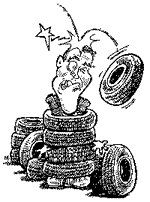| |
 Jim Grant's Tech Tips
Jim Grant's Tech Tips
‘95 GMC Pick-up, Wild Temp Gauge
Q: I have a Ď95 GMC pickup 350 power everything. The temperature gauge goes to 210 to 215 then back to 170. This may happen two to three times before it settles down to 195. I have changed the clutch fan, radiator, belt, both top and bottom hoses. The thermostat has been changed 4 times and still no luck. Where do I go from here? Any help would be great.
A#2
- Henry King
A:
There are 2 possible causes that come to mind with your vehicle. 1; There is air entering the cooling system. 2; The temperature gauge or sending unit for the gauge is wacked. I would start with a possible bad temperature gauge. The computer on your vehicle has a very precise coolant temperature sensor and in your vehicleís case, this sensorís information is not used for the gauge. It is only for the computer. Have your technician connect into the computer and monitor the temperature the computer sees at its own sensor. If the computerís temperature readings donít match up then the temperature gauge, wiring or sender for the gauge has a problem. If the computer is reporting temperature readings that are jumping around just the same as the temperature gauge on the dash is then I would be looking for air in the system. With all the cooling system work youíve performed I would hope that the system would have been pressure tested for leaks. Youíre not going to want to hear what I;ve got to tell you now. Iíll start with a question. How does air get into the cooling system? There is a leak. Youíve been through the cooling system 7 ways to Sunday and still have not found a cause. Thatís why Iím thinking you may have a crack in the cylinder head. Starting a cold engine, the crack will allow combustion gases to be pushed into the cooling system. As the cylinder head heats up the crack closes up. The temperature gauge goes nutz because pockets of air are moving around in the cooling system. After the thermostat cycles a couple of times the air is burped out to the radiator and then into the coolant reservoir. Once you allow the engine to cool the cycle starts all over again. Pull all the spark plugs and pressurize the cooling system over night. The next morning crank the engine over and watch for coolant. If Iíve gone down the right path Iíll bet a coffee that the problem will be in cylinder #5 or #7 in your Chevy motor.
|
|



